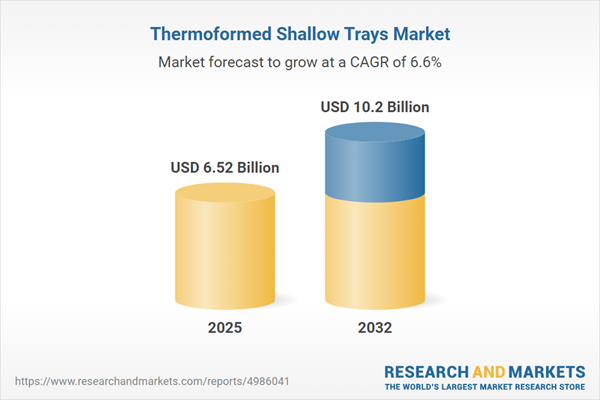Speak directly to the analyst to clarify any post sales queries you may have.
Thermoformed shallow trays have become essential packaging solutions across industries, valued for their efficiency and adaptability. As sustainability and product integrity rise to the forefront of business strategy, industry leaders are reevaluating packaging investments to meet evolving regulatory and consumer demands.
Market Snapshot: Thermoformed Shallow Trays Market Growth and Trajectory
The Thermoformed Shallow Trays Market grew from USD 6.11 billion in 2024 to USD 6.52 billion in 2025 and is projected to reach USD 10.20 billion by 2032, reflecting a CAGR of 6.59%. This robust marketplace responds to increasing global requirements for lightweight, cost-effective, and sustainable packaging. Heightened regulatory attention and rapid development within logistics and supply chain infrastructure further underpin this upward trend, positioning thermoformed shallow trays as strategic packaging solutions for forward-looking manufacturers and brands.
Scope & Segmentation: Strategic Insights into the Thermoformed Shallow Trays Market
- Material Types: High-impact polystyrene, polyethylene terephthalate, glycol-modified PET, polypropylene, and polyvinyl chloride shape tray durability, clarity, and recyclability.
- Packaging Formats: Blister packs, clamshells, and trays with lids each address specific security, logistical, and presentation needs across supply chains.
- End Use Applications: Automotive, consumer goods, electronics, food and beverage (including beverages, dairy, meat and seafood), and healthcare highlight the versatile role of shallow trays in product protection and enhanced shelf appeal.
- Geographic Reach: Offerings are tracked across subregions such as North America (including United States, Canada, Mexico), Latin America (Brazil, Argentina, Chile, Colombia, Peru), Europe, Middle East, Africa (United Kingdom, Germany, France, Russia, Italy, Spain, Netherlands, Sweden, Poland, Switzerland, United Arab Emirates, Saudi Arabia, Qatar, Turkey, Israel, South Africa, Nigeria, Egypt, Kenya), and Asia-Pacific (China, India, Japan, Australia, South Korea, Indonesia, Thailand, Malaysia, Singapore, Taiwan).
- Leading Companies: Anchor Packaging Inc., Amcor PLC, Berry Global Group, Coveris Holdings S.A., D&W Fine Pack LLC, Display Pack Inc., Placon Corporation, Reynolds Group Holdings, Rompa Holding B.V., Sabert Corporation, Sealed Air Corporation represent a competitive field advancing material innovation and operational performance.
Key Takeaways for Decision-Makers
- Rising sustainability mandates and food safety standards are accelerating adoption of recyclable materials and closed-loop manufacturing.
- Technological advances enable rapid prototyping, shortening lead times and boosting design flexibility for brands seeking product differentiation.
- Emerging digital tools, including smart sensors in trays, support freshness tracking and enhanced supply chain integrity.
- Diverse end-use demand—from precision requirements in automotive and electronics to freshness and presentation in food, beverage, and healthcare—drives continued innovation in tray material selection and design.
- Regional market distinctions compel tailored sourcing, compliance, and go-to-market strategies, enhancing resilience against policy and supply disruptions.
- Strategic collaboration between supply chain partners improves risk management and responsiveness in volatile global markets.
Tariff Impact: Navigating New Trade Dynamics in the United States
Recent tariff schedule adjustments in the United States have altered the cost structure for imported polymer sheets and finished trays. Companies are reassessing supply and procurement strategies to offset increased duties, including dual sourcing, investing in local sheet extrusion, and redesigning trays for material efficiency. These responses not only preserve margin but also reinforce supply chain resilience and agile market positioning as trade landscapes evolve.
Methodology & Data Sources
This analysis utilizes direct interviews with packaging engineers, procurement professionals, and sustainability leads. Supplementary surveys, government documentation, technical articles, and industry journals inform the research, with data triangulation ensuring consistency and reliability. Quantitative methods such as scenario modeling and qualitative panel reviews provide a comprehensive, unbiased understanding of market drivers and segmentation.
Why This Report Matters
- Offers actionable intelligence to guide sourcing, design, and investment decisions in a shifting regulatory and trade environment.
- Highlights strategic opportunities for differentiation and operational efficiency in a competitive, high-growth segment.
- Delivers nuanced analysis of regional and end-use market trends to support customized business development approaches.
Conclusion
The thermoformed shallow trays market is influenced by regulatory, technological, and regional trends reshaping supply chains and competitive strategies. Leaders that anticipate evolving packaging and trade demands will be best positioned for sustained success and market advantage.
Additional Product Information:
- Purchase of this report includes 1 year online access with quarterly updates.
- This report can be updated on request. Please contact our Customer Experience team using the Ask a Question widget on our website.
Table of Contents
3. Executive Summary
4. Market Overview
7. Cumulative Impact of Artificial Intelligence 2025
Companies Mentioned
The companies profiled in this Thermoformed Shallow Trays market report include:- Anchor Packaging Inc.
- Amcor PLC
- Berry Global Group, Inc.
- Coveris Holdings S.A.
- D&W Fine Pack LLC
- Display Pack Inc.
- Placon Corporation
- Reynolds Group Holdings Limited
- Rompa Holding B.V.
- Sabert Corporation
- Sealed Air Corporation
Table Information
| Report Attribute | Details |
|---|---|
| No. of Pages | 188 |
| Published | November 2025 |
| Forecast Period | 2025 - 2032 |
| Estimated Market Value ( USD | $ 6.52 Billion |
| Forecasted Market Value ( USD | $ 10.2 Billion |
| Compound Annual Growth Rate | 6.5% |
| Regions Covered | Global |
| No. of Companies Mentioned | 12 |









